Circus Immersion–Keeping the Movement Going in the Art of Being Upside Down
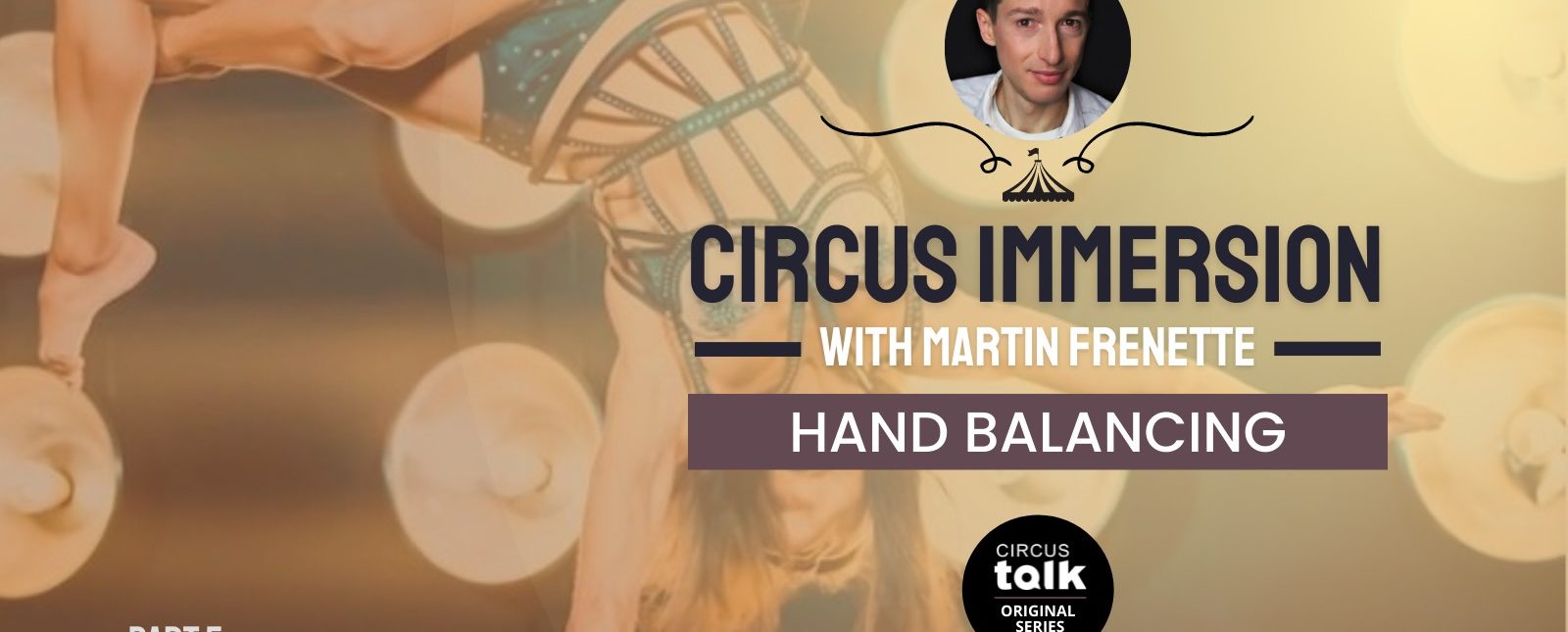
An Olympic diver slowly bends forward, lays his palms in front of his toes, and rises into a perfect handstand ten meters above the water. Two vibrant girls kick their legs up in the air at sunrise and walk down Times Square’s infamous red stairs. A gymnast turned biology teacher takes a sip of water and gets on his hands to demonstrate that one can swallow upside down.
There is something both extraordinary and casual about someone pushing through their shoulders, squeezing their ribs in, and creating a perfect line from the floor to the tip of their toes. Some circus disciplines such as Washington trapeze and contortion have integrated hand balancing elements to their acts’ composition and there isn’t a kid who hasn’t tried finding that perfect, centered spot on the playground.
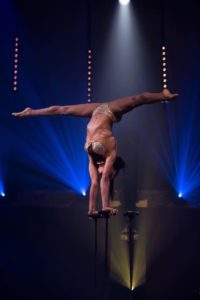
For some, hand balancing is an influential part of their yoga practice while others see it as a challenge to succeed by their 40th birthday. Shenea Stiletto sees it as the art of being upside down and of getting to a place where that feels natural. Hand balancing offers a unique point of view of the world in a discipline where body manipulation and awareness are as important as balance itself. There is a level of physicality that exceeds expectations when done properly. The former acro sports champion affirms that a perfect handstand feels like levitation and transcends physical limitations.
Having spent two decades relying partly on a partner to keep her in balance, Stiletto felt the need for a change and the desire to create a very dynamic solo with hand balancing at its core. Inspired by Olga Pikhienko’s act from Cirque du Soleil‘sQuidam, her first goals were to find stability on flat blocks, not her familiar gymnastics’ angled ones, and to complete a one-arm rotation on turning canes. Finding the right movement quality and blending it with the canes’ rotating rhythm is a challenge that stopped some hand balancers from reaching new heights; she however rose to the occasion! Doubling in efforts to bring her vision to life, she even asked a friend to spot her so that no fall would disturb her creativity in her research and exploration phases.
“It took about a year to become comfortable on my canes, in spite of my extensive acrobatic background and countless hours spent on my hands. This initial insecurity still creeps in every now and then. Hand balancing is an insecure discipline and understanding how to rotate properly is a lengthy process. I wish I’d had someone guiding me and feeding me tips on my solo path,” explains the young woman.
Without taking anything away from those hard-to-hold positions, one must admit that hand balancing sometimes is more about the way the artist gets into them. Getting in a specific shape and transitioning to the next one has often struck the imagination on a deeper level. The technical level gets higher every year and with every generation of hand balancers, but one’s body control and unique way of connecting various poses can move audiences as much as their technique. In the same way that seeing a diver raising his feet has become somewhat normal, some positions can convey a déjà-vu vibe to knowing audiences. On the other hand, choreography offers an elongated amount of time to connect with and captivate the audience. One’s originality in those in-betweens can express as much as that unshakable one-arm.
“Hand balancing forces the artist and audience to take a moment, breathe, and really engage on an artistic level. Spectators don’t know how long they’ll wait to see what’s next and this wait can be as interesting an experience as one’s strongest tricks,” she adds.
As for how other disciplines are and have been intertwining with her specialty, Stiletto agrees that hand balancing and contortion have been feeding off each other for quite some time. However, as Cirque du Soleil’s head coach once pointed out during herVarekai rehearsal process: one is not the other and vice versa. Some disciplines can blend well on stage, to the point that it changes the way people look at them, but they remain distinctive. A good flexibility level broadens a hand balancer’s movement possibilities, reduces their body’s restriction, but they don’t have to be contortionists to stand out.
When asked about this constant quest for balance and whether it comes between her and the audience, Stiletto spontaneously answers that her state of mind often is more of a factor in this connection. Adding new elements to a well-established routine is likely to take her focus away and she openly admits that a lack of preparation can deprive her of connecting with the audience. A 70-30% focus ratio that gives most to the spectators is a healthy one in her opinion. Their response and energy have proven to be quite the motivation to rotate faster and fully abandon herself to her character.
Currently re-working her signature piece performed on a two-meter high stiletto, the 35-year old pauses for a moment and sums it all up on a lonesome, yet positive note: “Hand balancing is a long journey where one has to be very patient while experiencing solitude, but this loneliness is beautiful.”
Keeping a Constant Flow and Never Stopping
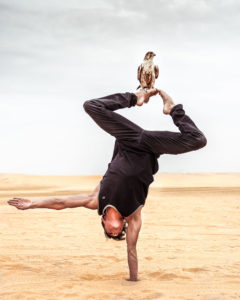
As one hand balancer finds inspiration high above the ground, another focuses on a table and a chair. Nicolas Montes de Oca is indeed revisiting the piece he performed at the Festival du Cirque de Demain in 2019 with the aim of making it a one-man show.
Born in Mexico City with an interest in performing arts, the aspiring juggler was unaware of circus schools’ very existence until his encounter with a troupe fresh from Quebec’s program at a European juggling convention. Inspired by how different and creative contemporary circus could be, he set out to join a professional school and become a full-time juggler. A tumbling incident at Beijing’s International Artes School however swayed him to consider a career on his hands.
“A coach suggested I give hand balancing a try after I broke my foot. Being forced to keep it off the floor made this training more enjoyable and less painful than any other. I then moved to Kiev and kept training at their art academy. I loved it there and would have gone through their entire program, but visa and governmental issues forced me to leave. My training journey ended with a four-year stay in Shanghai, where finding vegetarian food was as challenging as the language!” he concludes with a little laugh.
Really wanting to find his own way of moving and avoid looking like one among many who do the same tricks, Montes chose early on to stay clear of hand-balancing videos and other people’s work. His research and way of moving are and have been about integrating various forms of movement into his acrobatic skills.
Dance and many choreographers’ interest in the contemporary circus has allowed hand balancing to go through an artistic renaissance. The prowess factor remains in the sense that someone keeping their body perfectly aligned in the most intricate position has always prompted crowds to cheer. Some hand balancers still go for the stunt-driven and strength-led acts, but many have chosen to depart from the freeze-cheers-and-go formula. Montes affirms that hand balancing doesn’t have to be so square to captivate audiences and that many dancers, such as Canadian choreographer Crystal Pite, have inspired him much more than the industry’s strongest hand balancers.
There is an important mind-over-matter aspect to hand balancing and one must learn to trust their body to get over doubt.
The discipline’s nature requires one to hit each mark with at least two extremities up in the air and that rule has turned a restriction into a broad spectrum of possibilities for feet and legs. Ten hand balancers with ten different levels of body awareness and movement training can execute the same trick without ever looking alike.
“Hand balancers tend to have a better awareness of their lower body. Our legs and feet are freer than in other disciplines and this freedom pushes those limbs’ exploration further,” Montes adds.
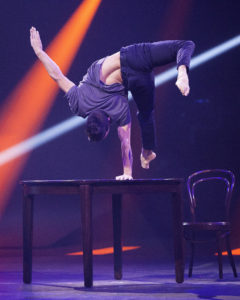
Aside from the transition work and a will to let the movement take over crowd-pleasing tricks, hand balancers often share an appreciation for stillness and for what strength and stability can convey when united. Drum rolls can still announce a fierce acrobat’s show-stopping finale at the traditional circus. However, the stillness with which he holds himself is as likely to move the crowd as facial convulsions or a bulging bicep.
There is an important mind-over-matter aspect to hand balancing and one must learn to trust their body to get over doubt. The 34-year old describes it as getting in an auto-pilot mode and trusting that they can perform in front of an audience as well as they did behind closed doors.
“You’ve done these tricks thousands of times. You know what to do and must trust yourself. Stop thinking and just do it!”
Quickly changing and softening the tone of his voice, Montes reminds hand balancers that training does not have to be all press-ups and push-ups. His own regiment has shifted away from technique to creating connections between poses and finding a concept that fits the whole. Such an approach helps him from stagnating and keeps each performance fresh. From The 7 Fingers‘ Triptyque and Vice & Virtue to the Cirque de Demain, Montes feels that each has somewhat been about keeping a constant flow going and never stopping. That is a hand balancer’s real challenge and ultimate goal.
A Conscious Trance
Miles away from Mexico, one of his Montréal-based Triptyque colleagues agrees that hand balancing cannot solely be about technique. This way of moving can be an art form when used to express what one wants rather than to simply impress.
“Hand balancing is good at expressing fragility and suspension. This moment frozen in time gives a special quality to the body. Movement can express as much as stillness, even if prowess remains a huge part of the discipline’s nature.” says Marie-Ève Dicaire.
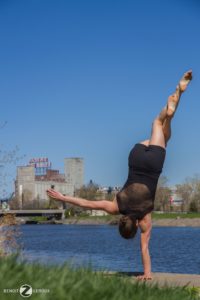
The former dance student auditioned for Montreal’s national circus school without a clear career plan nor hand balancing ambitions as a matter of fact. Various movement forms have always inspired her, but her college’s dance program lacked something that she couldn’t quite pin down. Her first training year at ENC felt like a long try-out with constant, but very small steps that made her doubt that creating a full act or succeeding at a one-arm press-up by graduation day was possible.
Recognizing herself in the discipline’s calmness and use of movement, she came back for her second year with the will and determination to develop the skills she needed to express herself and let the movement speak for itself.
“I never actually chose hand balancing as my major, it just appeared in my schedule more than any other discipline. I quickly realized that this training is as demanding psychologically as it is physically and has always felt more complete,” Dicaire adds.
Much like her Mexican colleague, the Montréaler appreciates the discipline’s use of stillness and how being in constant motion is not the only way to reach the audience. This frozen shape gives a completely different color to the movement that came before.
As for these different colors and her vocabulary’s genesis, their roots all go back to her feelings and state of mind on one or two hand(s). Dicaire’s research and approach have evolved through time and so did her personality. Consequently, her movements and acts’ structure never stopped changing and this constant evolution prevented her from an artistic spleen.

The audience and how differently they react to her performance, from Cirque Plume to the Tigerpalast Varieté, has also been an important reason for her lasting career.
“Being on stage feels like a conscious trance. I’m there, with the audience, fully aware of their presence and of my body. Both rapports are tightly linked and being conscious of how both feel in a given moment can make all the difference.”
Lastly, all three hand balancers agree that walking is walking. Whether it’s on your hands or on your feet, the concept remains the same. Both walks are about catching your weight before it goes off balance and finding that stable, centered spot. Would someone really feel more or as comfortable walking on their hands if that’s the position they’ve been put in from the moment they were born? Are any future parents reading this piece ready to give it a try and always favor hands over feet with their newborn?
All photos provided courtesy of the artists. Feature image Shenea Stiletto.
Editor's Note: At StageLync, an international platform for the performing arts, we celebrate the diversity of our writers' backgrounds. We recognize and support their choice to use either American or British English in their articles, respecting their individual preferences and origins. This policy allows us to embrace a wide range of linguistic expressions, enriching our content and reflecting the global nature of our community.
🎧 Join us on the StageLync Podcast for inspiring stories from the world of performing arts! Tune in to hear from the creative minds who bring magic to life, both onstage and behind the scenes. 🎙️ 👉 Listen now!
